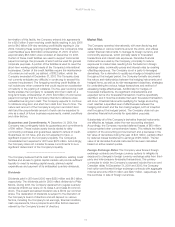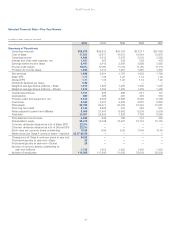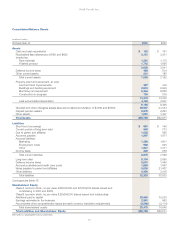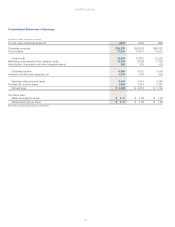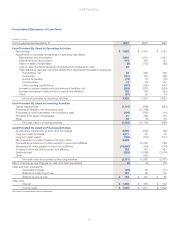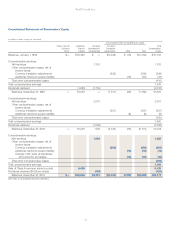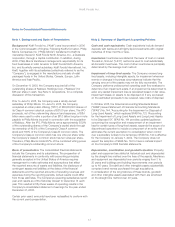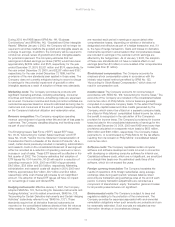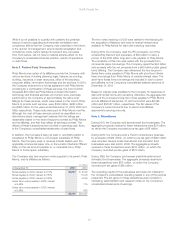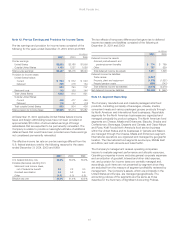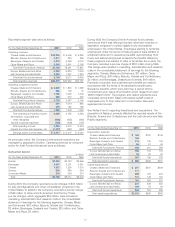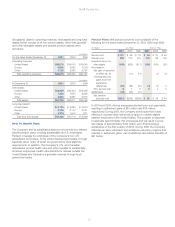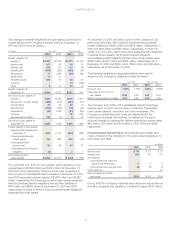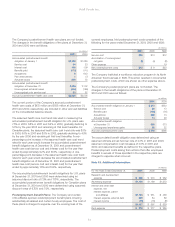Kraft 2001 Annual Report Download - page 49
Download and view the complete annual report
Please find page 49 of the 2001 Kraft annual report below. You can navigate through the pages in the report by either clicking on the pages listed below, or by using the keyword search tool below to find specific information within the annual report.
Kraft Foods Inc.
43
Note 1. Background and Basis of Presentation:
Background: Kraft Foods Inc. (“Kraft”) was incorporated in 2000
in the Commonwealth of Virginia. Following Kraft’s formation, Philip
Morris Companies Inc. (“Philip Morris”) transferred to Kraft its
ownership interest in Kraft Foods North America, Inc., a Delaware
corporation, through a capital contribution. In addition, during
2000, Philip Morris transferred management responsibility for its
food businesses in Latin America to Kraft Foods North America,
Inc. and its wholly-owned subsidiary, Kraft Foods International, Inc.
Kraft, together with its subsidiaries (collectively referred to as the
“Company”), is engaged in the manufacture and sale of retail
packaged foods in the United States, Canada, Europe, Latin
America and Asia Pacific.
On December 11, 2000, the Company acquired all of the
outstanding shares of Nabisco Holdings Corp. (“Nabisco”) for
$55 per share in cash. See Note 5, Acquisitions, for a complete
discussion of this transaction.
Prior to June 13, 2001, the Company was a wholly-owned
subsidiary of Philip Morris. On June 13, 2001, the Company
completed an initial public offering (“IPO”) of 280,000,000 shares of
its Class A common stock at a price of $31.00 per share. The IPO
proceeds, net of the underwriting discount and expenses, of $8.4
billion were used to retire a portion of an $11.0 billion long-term note
payable to Philip Morris incurred in connection with the acquisition
of Nabisco. After the IPO, Philip Morris owns approximately 83.9%
of the outstanding shares of the Company’s capital stock through
its ownership of 49.5% of the Company’s Class A common
stock and 100% of the Company’s Class B common stock. The
Company’s Class A common stock has one vote per share while
the Company’s Class B common stock has ten votes per share.
Therefore, Philip Morris holds 97.7% of the combined voting power
of the Company’s outstanding common stock.
Basis of presentation: The consolidated financial statements
include the Company and its subsidiaries. The preparation of
financial statements in conformity with accounting principles
generally accepted in the United States of America requires
management to make estimates and assumptions that affect
the reported amounts of assets and liabilities, the disclosure of
contingent assets and liabilities at the dates of the financial
statements and the reported amounts of operating revenues and
expenses during the reporting periods. Actual results could differ
from those estimates. The Company’s operating subsidiaries report
year-end results as of the Saturday closest to December 31 each
year. This resulted in fifty-three weeks of operating results in the
Company’s consolidated statement of earnings for the year ended
December 31, 2000.
Certain prior years’ amounts have been reclassified to conform with
the current year’s presentation.
Note 2. Summary of Significant Accounting Policies:
Cash and cash equivalents: Cash equivalents include demand
deposits with banks and all highly liquid investments with original
maturities of three months or less.
Inventories: Inventories are stated at the lower of cost or market.
The last-in, first-out (“LIFO”) method is used to cost substantially
all domestic inventories. The cost of other inventories is principally
determined by the average cost method.
Impairment of long-lived assets: The Company reviews long-
lived assets, including intangible assets, for impairment whenever
events or changes in business circumstances indicate that the
carrying amount of the assets may not be fully recoverable. The
Company performs undiscounted operating cash flow analyses to
determine if an impairment exists. If an impairment is determined to
exist, any related impairment loss is calculated based on fair value.
Impairment losses on assets to be disposed of, if any, are based
on the estimated proceeds to be received, less costs of disposal.
In October 2001, the Financial Accounting Standards Board
(“FASB”) issued Statement of Financial Accounting Standards
(“SFAS”) No. 144, “Accounting for the Impairment or Disposal of
Long-Lived Assets,” which replaces SFAS No. 121, “Accounting
for the Impairment of Long-Lived Assets and Long-Lived Assets
to be Disposed Of.” SFAS No. 144 provides updated guidance
concerning the recognition and measurement of an impairment
loss for certain types of long-lived assets, expands the scope of a
discontinued operation to include a component of an entity and
eliminates the current exemption to consolidation when control
over a subsidiary is likely to be temporary. SFAS No. 144 is effective
for the Company on January 1, 2002. The Company does not
expect the adoption of SFAS No. 144 to have a material impact
on the Company’s 2002 financial statements.
Depreciation, amortization and goodwill valuation: Property,
plant and equipment are stated at historical cost and depreciated
by the straight-line method over the lives of the assets. Machinery
and equipment are depreciated over periods ranging from 3 to
20 years and buildings and building improvements over periods
up to 40 years. Goodwill and other intangible assets substantially
comprise brand names purchased through acquisitions.
In consideration of the long histories of these brands, goodwill
and other intangible assets associated with them are amortized
on the straight-line method over 40 years.
Notes to Consolidated Financial Statements



